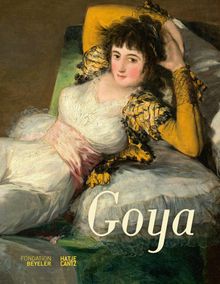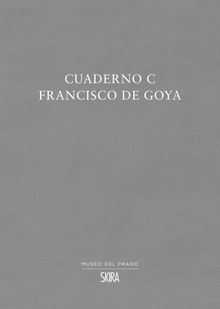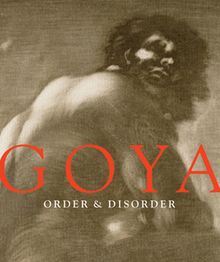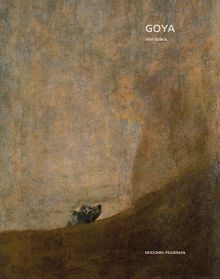| |||||||||||||||||||||||||
ARTIST MONOGRAPHS
|
|
in stock $60.00 Free Shipping UPS GROUND IN THE CONTINENTAL U.S. |
 Francisco de Goya: Exhibition Guide
Francisco de Goya: Exhibition Guide
Published by Hatje Cantz.
Edited with text by Martin Schwander. Text by Andreas Beyer, Helmut C. Jacobs, Ioana Jimborean, José Manuel Matilla, Gudrun Maurer, Manuela B. Mena Marqués, Colm Tóibín, Bodo Vischer.
Francisco de Goya was one of the last great court artists and a significant trailblazer for modern art—and now, the Fondation Beyeler, in collaboration with the Museo Nacional del Prado, has mounted one of the most extensive exhibitions of his work outside of Spain, a major event commemorated with this monumental publication.
In a career of more than 60 years, Goya acted as an astute observer of the drama of reason and irrationality, of dreams and nightmares. His pictures show things that go beyond social conventions: he depicts saints and criminals, witches and demons, breaking open the gates to realms where the boundaries between reality and fantasy blur. The Fondation Beyeler exhibition and its accompanying catalog gathers more than 70 paintings, around 60 masterful drawings and a selection of prints that invite the viewer to an encounter with Goya’s vision of the beautiful, as well as the incomprehensible. For the first time, rarely seen paintings from private collections in Spain have been united with key works from the most famous European and American museums and private collections. This extensive catalog examines Goya’s unique artistic impact in texts by renowned interpreters, and features splendid photographic illustrations.
The work of Spanish painter Francisco de Goya (1746–1828) covers the spectrum from the Rococo to Romanticism. The last of the Old Masters and the first of the moderns, Goya was both a transitional and completely singular figure, a chronicler of the events and protagonists of his day and an explorer of timeless interior realms.
PUBLISHER
Hatje Cantz
BOOK FORMAT
Hardcover, 10.75 x 12.25 in. / 400 pgs / 300 color.
PUBLISHING STATUS
Pub Date 12/7/2021
Active
DISTRIBUTION
D.A.P. Exclusive
Catalog: SPRING 2020 p. 57
PRODUCT DETAILS
ISBN 9783775746571 TRADE
List Price: $90.00 CAD $124.00
AVAILABILITY
In stock
in stock $90.00 Free Shipping UPS GROUND IN THE CONTINENTAL U.S. |
 Francisco de Goya: Cuaderno C
Francisco de Goya: Cuaderno C
Published by Skira.
Text by José Manuel Matilla Rodríguez.
In collaboration with the Museo Nacional del Prado in Madrid on the occasion of its 200th anniversary in 2019, Skira has published an accurate reproduction of Francisco Goya’s (1746-1828) precious Cuaderno C, or Album C in English. Containing more than 100 drawings from the years 1808 to 1820, Cuaderno C covers a wide variety of charged topics, clearly influenced by the events of the Peninsular War and its turbulent aftermath. Goya devoted a large section of the album to drawings that depict prisoners of the Inquisition and their suffering while incarcerated; another section critiques the representation of monastic life, which was secularized in keeping with the French authorities’ orders.
Unlike the first two drawing albums, which were professionally bound with high-quality Dutch paper, Goya made Cuaderno C himself out of the cheaper Spanish paper available to him at the time, making the volume’s survival all the more remarkable. An essay by José Manuel Matilla Rodríguez, art historian and head of the Department of Drawings and Prints at the Museo Nacional del Prado, accompanies the drawings.
PUBLISHER
Skira
BOOK FORMAT
Paperback, 6.5 x 8.75 in. / 288 pgs / 133 color.
PUBLISHING STATUS
Pub Date 9/15/2020
Active
DISTRIBUTION
D.A.P. Exclusive
Catalog: FALL 2020 p. 142
PRODUCT DETAILS
ISBN 9788857243627 TRADE
List Price: $45.00 CAD $63.00
AVAILABILITY
In stock
in stock $45.00 Free Shipping UPS GROUND IN THE CONTINENTAL U.S. |
 Goya: Order & Disorder
Goya: Order & Disorder
Published by MFA Publications, Museum of Fine Arts, Boston.
Text by Stephanie Loeb Stepanek, Frederick Ilchman, Janis A. Tomlinson, Clifford S. Ackley, Jane E. Braun, Manuela B. Mena Marqués, Gudrun Maurer, Elisabetta Polidori, Sue W. Reed, Benjamin Weiss, Juliet Wilson-Bareau.
Francisco José Goya y Lucientes (1746–1828) was born in Fuendetodos, Aragón, in the northeast of Spain. Goya was court painter to the Spanish Crown, and famously documented the Peninsular War (1807–1814) between France and Spain in his harrowing Disasters of War series. An important bridge to the modernist era, Goya's oeuvre provided a crucial precedent for artists such as Manet, Picasso and Francis Bacon.
PUBLISHER
MFA Publications, Museum of Fine Arts, Boston
BOOK FORMAT
Clth, 9.25 x 11 in. / 400 pgs / 260 color.
PUBLISHING STATUS
Pub Date 10/31/2014
Out of print
DISTRIBUTION
D.A.P. Exclusive
Catalog: FALL 2014 p. 9
PRODUCT DETAILS
ISBN 9780878468089 TRADE
List Price: $65.00 CAD $87.00 GBP £40.00
AVAILABILITY
Not available
STATUS: Out of print | 00/00/00 For assistance locating a copy, please see our list of recommended out of print specialists |
 Goya
Goya
Published by Ediciones Polígrafa.
Text by José Gudiol.
Nobody expressed the ravages of warfare and the extremes of human experience like Goya; it made him the envy of Picasso, who, as a young artist, copied his signature over and over, as though to absorb the personality and abilities of his one supreme influence. And it is perhaps the wildly imaginative freedoms of Goya’s late work that has kept him so contemporary--that, and the palpable emotion in his brushwork, so full of impact and sensation. Here, José Gudiol, renowned author of essays and monographs on Velázquez, El Greco and Spanish art, provides a serious introduction to the massive subject that is Goya.
PUBLISHER
Ediciones Polígrafa
BOOK FORMAT
Hardback, 8.75 x 11.5 in. / 128 pgs / 122 color.
PUBLISHING STATUS
Pub Date 11/1/2008
Out of print
DISTRIBUTION
D.A.P. Exclusive
Catalog: SPRING 2008 p. 66
PRODUCT DETAILS
ISBN 9788434311749 TRADE
List Price: $34.00 CAD $45.00
AVAILABILITY
Not available
STATUS: Out of print | 00/00/00 For assistance locating a copy, please see our list of recommended out of print specialists |
 Goya & Italy
Goya & Italy
Published by Turner.
Edited by Joan Sureda.
PUBLISHER
Turner
BOOK FORMAT
Paperback, 9.5 x 12 in. / 310 pgs / 350 color.
PUBLISHING STATUS
Pub Date 9/1/2008
Out of print
DISTRIBUTION
D.A.P. Exclusive
Catalog: FALL 2008 p. 22
PRODUCT DETAILS
ISBN 9788475068084 TRADE
List Price: $69.00 CAD $85.00
AVAILABILITY
Not available
STATUS: Out of print | 00/00/00 For assistance locating a copy, please see our list of recommended out of print specialists |
